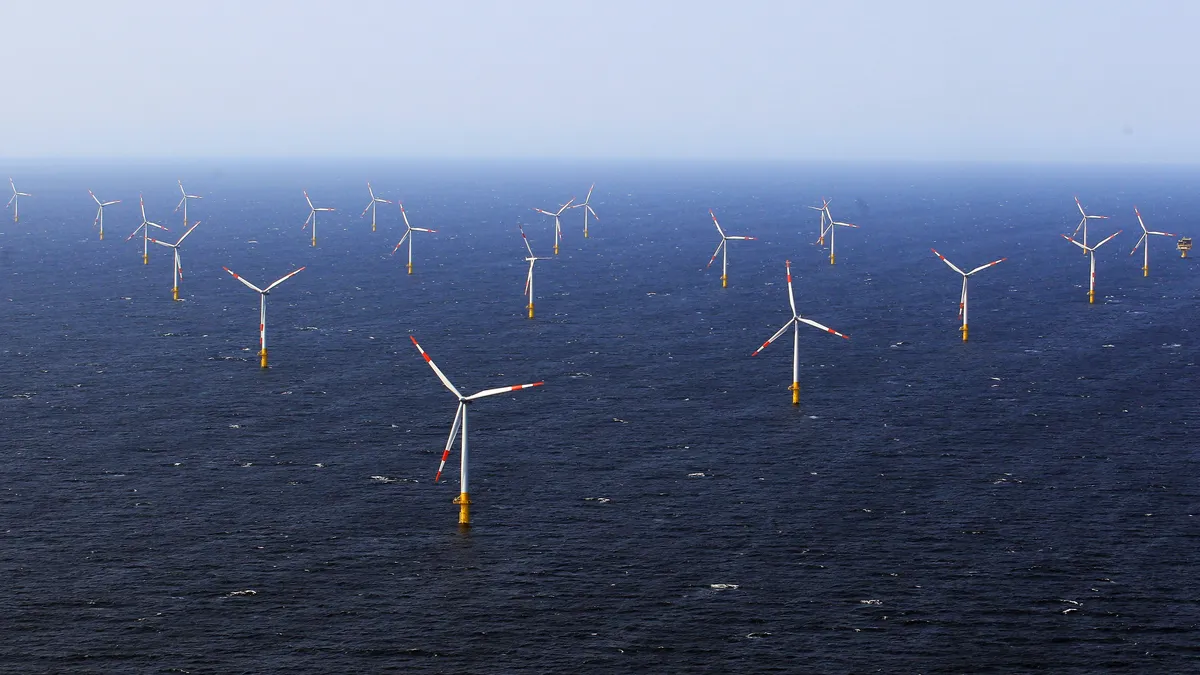Dive Brief:
-
It will cost $2.2 billion to $3.2 billion to build enough transmission in the PJM Interconnection to meet states' offshore wind and renewable portfolio standard goals through 2035, according to a study by the grid operator.
-
The transmission projects and renewable generation would lower customer costs by reducing the use of more expensive fossil-fueled power plants and removing transmission bottlenecks on the grid while allowing for more exports to the Midcontinent Independent System Operator, PJM said in the report released Tuesday.
-
The report presents a framework for future transmission planning studies between PJM and states, according to the grid operator. PJM said states can ask for more scenarios for PJM to model, which could help coastal states craft offshore wind solicitations.
Dive Insight:
The report, developed at the request of states, signals a change in how the grid operator considers transmission development, according to Mike Jacobs, a senior energy analyst at the Union of Concerned Scientists.
"We've always observed, it's easier to build the wind farms than to build the transmission," Jacobs said. "The wind farms go up, and the transmission system lags behind it."
Jacobs said the report presents a "first picture" of where transmission will have to go and what it will cost to meet state energy goals in PJM's footprint, which includes 13 Mid-Atlantic and Midwest states and the District of Columbia.
"It's exactly what we need to be doing," Jacobs said.
In its analysis of five scenarios, PJM assumed states in its footprint would need about 45,575 MW of solar, 14,530 MW of onshore wind, 14,415 MW of offshore wind and 7,190 MW of energy storage to meet their energy goals by 2035.
Only needing to spend $2.2 billion to $3.2 billion for the onshore transmission required to deliver that power is a "good surprise," Jacobs said.
"By synchronizing the planning of its coastal states' offshore wind deployment, PJM is able to identify transmission solutions that could present a more efficient and economic path for states to achieve their offshore wind policy objectives than if each state integrated their offshore wind generation completely independent of one another," the grid operator said.
The study is a starting point for future scenarios that consider integrating offshore wind and other renewable resources into the PJM system, according to the grid operator.
PJM found the new transmission and renewable energy additions would generally lower consumer electricity costs, but more studies are needed to flesh out the extent of those savings.
The study was released as Federal Energy Regulatory Commission Chairman Richard Glick has been calling for transmission planning to take into account the future needs of the grid.
FERC is considering revising its rules governing transmission planning, cost allocation and power plant interconnections. In an advanced notice of proposed rulemaking (ANOPR), FERC said it may order grid operators to identify potential renewable energy zones and plan transmission to serve those areas.
"PJM's report is another valuable step in quantifying what it will take to meet states' clean energy goals consistent with some of FERC's questions in its ANOPR," Gabe Tabak, American Clean Power Association counsel for federal regulatory affairs, said.
The clean energy industry wants to see transmission planning that fully accounts for meeting state goals, while also meeting economic and reliability objectives, Tabak said.
Tabak cautioned that while PJM's report provides valuable information, it leaves most of the next steps to the states in terms of offshore wind solicitations and whether they adopt the grid operator's "state agreement approach."
"We think the next step is incorporating this analysis into PJM'S transmission planning, alongside other drivers," Tabak said.
The study comes amid increased activity around offshore wind and transmission planning.
PJM and New Jersey are reviewing transmission proposals to bring power from planned offshore wind farms into the state. They are cooperating using PJM's state agreement approach, which would require New Jersey's ratepayers to pay for any new power lines that are built for the wind farms.
The transmission issue may be discussed Thursday at the House Energy and Commerce Committee's energy subcommittee hearing on offshore wind.
And on Oct. 29, the Interregional Planning Stakeholder Advisory Committee is considering a request by a coalition of clean energy advocates that ISO New England, the New York Independent System Operator and PJM jointly study transmission solutions for offshore wind between New York and New Jersey. They also called for an assessment of an offshore transmission network from Massachusetts to North Carolina.














